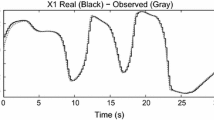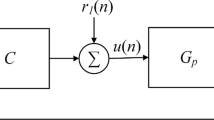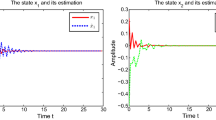Abstract
This work proposes a discrete-time non-linear neural observer based on a recurrent high order neural network in parallel model trained with an algorithm based on the extended Kalman filter for discrete-time multiple input multiple output non-linear systems with unknown dynamics and unknown time-delay. To prove the semi-globally uniformly ultimately boundedness of the proposed neural observer the stability analysis based on the Lyapunov approach is included. Applicability of the proposed observer is shown via simulation and experimental results.










Similar content being viewed by others
Notes
Matlab is a registered trademark of MathWorks Inc.
Simulink is a registered trademark of MathWorks Inc.
LabVolt is a registered trademark of Festo Didactic Inc.
dSPACE is a registered trademark of dSPACE GmbH.
ControlDesk is a registered trademark of dSPACE GmbH.
References
Alanis AY, Rios JD, Arana Daniel N, Lopez Franco C (2016) Neural identifier for unknown discrete-time nonlinear delayed systems. Neural Comput Appl 27(8):1–12
Alanis AY, Rios JD, Rivera J, Arana-Daniel N, Lopez-Franco C (2015) Real-time discrete neural control applied to a linear induction motor. Neurocomputing 164:240–251
Arana-Daniel N, Gallegos AA, Lopez-Franco C, Alanis AY (2014) Smooth global and local path planning for mobile robot using particle swarm optimization, radial basis functions, splines and bezier curves. In: 2014 IEEE congress on evolutionary computation (CEC), pp 175–182
Benitez VH, Loukianov AG, Sanchez EN (2003) Neural identification and control of a linear induction motor using an alpha–beta model. In: Proceedings of the 2003 American control conference, 2003, vol 5, pp 4041–4046
Boukas E, Liu Z (2012) Deterministic and stochastic time-delay systems. Control Engineering, Birkhäuser, Boston
Chang P, Lee JW (1995) Time delay observer: a robust observer for nonlinear plants using time-delayed signals. In: Proceedings of the 1995 American control conference, vol 3, pp 1638–1642
Chang P, Park S (1998) The enhanced time delay observer for nonlinear systems. In: Proceedings of the 37th IEEE conference on decision and control, 1998, vol 1, pp 367–368
Ellis G (2002) Observers in control systems: a practical guide. Elsevier, San Diego, CA
Fridman E (2014) Introduction to time-delay systems: analysis and control. Systems & control: foundations & applications. Springer, New York
Gieras J (1994) Linear induction drives. Monographs in electrical and electronic engineering. Clarendon Press, New York
Hagan M, Demuth H, Beale M, De Jesús O (2014) Neural network design, 2nd edn. Martin Hagan, Boston
Haykin S (2004) Kalman filtering and neural networks. Adaptive and cognitive dynamic systems: signal processing, learning, communications and control. Wiley, New York
Haykin S (2011) Neural networks and learning machines. Pearson Education, Upper Saddle River, NJ
Hermans M, Schrauwen B (2010) One step Back propagation through time for learning input mapping in reservoir computing applied to speech recognition. In: Proceedings of 2010 IEEE international symposium on circuits and systems (ISCAS), pp 521–524
Krstic M, Bekiaris Liberis N (2012) Control of nonlinear delay systems: a tutorial. In: 2012 IEEE 51st annual conference on decision and control (CDC), pp 5200–5214
Leondes C (1998) Neural network systems techniques and applications: advances in theory and applications. Elsevier, Amsterdam
Loukianov AG, Rivera J, nedo JMC (2002) Discrete-time sliding mode control of an induction motor. In: IFAC proceedings of 15th IFAC world congress, vol 35(1), pp 19–24
Lu G, Ho D (2004) Robust H \(\i \infty \); observer for nonlinear discrete systems with time delay and parameter uncertainties. IEEE Proc Control Theory Appl 151(4):439–444
Mahmoud M (2000) Robust control and filtering for time-delay systems. Automation and control engineering. Taylor & Francis, New York
Mahmoud M (2010) Switched time-delay systems: stability and control. Springer, New York
Na J, Herrmann G, Ren X, Barber P (2009) Nonlinear observer design for discrete MIMO systems with unknown time delay. In: Proceedings of the 48th IEEE conference on decision and control, 2009 held jointly with the 2009 28th Chinese control conference. CDC/CCC 2009, pp 6137–6142
Raff T, Allgower F (2006) An EKF-based observer for nonlinear time-delay systems. In: American control conference, 2006, p 4
Rajapakse J, Wang L (2004) Neural information processing: research and development. Lecture notes in computer science. Springer, Berlin
Rios J, Alanis A, Rivera J, Hernandez Gonzalez M (2013) Real-time discrete neural identifier for a linear induction motor using a dSPACE DS1104 board. In: The 2013 international joint conference on neural networks (IJCNN), pp 1–6
Ruliang W, Huiying J (2010) Observer-based adaptive neural network robust control of nonlinear time-delay systems with unmodeled dynamics. In: 2010 international conference on computational intelligence and security (CIS), pp 506–510
Sanchez E, Alanis A, Loukianov A (2008) Discrete-time high order neural control: trained with kalman filtering. Studies in computational intelligence. Springer, Berlin
Song Y, Grizzle J (1992) The extended Kalman filter as a local asymptotic observer for nonlinear discrete-time systems. In: American control conference, 1992, pp 3365–3369
Toliyat H, Kliman G (2004) Handbook of electric motors. CRC Press, Boca Raton
Valencia-Murillo R, Arana-Daniel N, Lopez-Franco C, Alanis AY (2013) Rough terrain perception through geometric entities for robot navigation. In: 2nd international conference on advances in computer science and engineering (CSE 2013). Atlantis Press
Wen Y, Ren X (2009) Robust adaptive control based on neural state observer for nonlinear time-delay systems. In: IEEE international conference on control and automation, 2009. ICCA 2009, pp 1178–1183
Xiao L (2015) A finite-time convergent neural dynamics for online solution of time-varying linear complex matrix equation. Neurocomputing 167:254–259
Xiao L (2016) A nonlinearly activated neural dynamics and its finite-time solution to time-varying nonlinear equation. Neurocomputing 173, Part 3:1983–1988
Xiao L, Lu R (2015) Finite-time solution to nonlinear equation using recurrent neural dynamics with a specially-constructed activation function. Neurocomputing 151, Part 1:246–251
Xu H, Jagannathan S (2013) Neural network based finite horizon stochastic optimal controller design for nonlinear networked control systems. In: The 2013 international joint conference on neural networks (IJCNN), pp 1–7
Xu Z, Li X (2010) Control design based on state observer for nonlinear delay systems. In: 2010 Chinese control and decision conference (CCDC), pp 1946–1950
Yi S, Nelson P, Ulsoy A (2010) Time-delay systems: analysis and control using the Lambert W function. World Scientific, New Jersey
Yu W, Sanchez E (2009) Advances in computational intelligence. Advances in intelligent and soft computing. Springer, Berlin
Zhang Y, Sircoulomb V, Langlois N (2012) Observer design for discrete-time systems subject to long time-delay. In: 2012 24th Chinese control and decision conference (CCDC), pp 2949–2954
Zhong Q (2006) Robust control of time-delay systems. Springer, London
Acknowledgements
The authors thank the support of CONACYT Mexico, through Projects CB256769 and CB258068 (“Project supported by Fondo Sectorial de Investigacin para la Educación).
Author information
Authors and Affiliations
Corresponding author
Appendix
Appendix
Proof of Theorem 1
Consider the candidate Lyapunov function
whose first increment is defined as
Using (9), (13) and (16) in (26)
with
Using the inequalities
which are valid \(\forall X,Y \in \mathfrak {R}^n,\forall P \in \mathfrak {R}^{n \times n}, P = P^\top > 0\) then (28) can be rewritten as
then
substituting f(k), then
Defining
then (31) can be express as:
Hence, \({\varDelta V}_{i}(k) < 0\) when
or
Therefore, the solution of (19) and (13) is stable; hence the estimation error and the RHONN weights are SGUUB. Considering (15) and (12), it is easy to see that the output error has an algebraic relation with \(\tilde{x}(k)\), for that reason. if \(\tilde{x}(k)\) is bounded, e(k) is bounded too.
\(\square \)
Remark 1
Considering Theorem 1 and its proof, it can be easily shown that the result can be extended to systems with multiple delays like \(x\left( k-l_{i}\right) \) with \(i=1,2,\ldots \), instead of \(x\left( k-l\right) \) in (2) and/or for time-variying delays \(x\left( k-l_{i}\left( k\right) \right) \) with \(l_{i}\left( k\right) \) bounded by \(l_{i}\left( k\right) \le l\).
Rights and permissions
About this article
Cite this article
Rios, J.D., Alanis, A.Y., Arana-Daniel, N. et al. Recurrent High Order Neural Observer for Discrete-Time Non-Linear Systems with Unknown Time-Delay. Neural Process Lett 46, 663–679 (2017). https://doi.org/10.1007/s11063-017-9617-3
Published:
Issue Date:
DOI: https://doi.org/10.1007/s11063-017-9617-3




